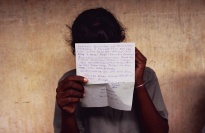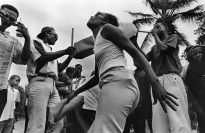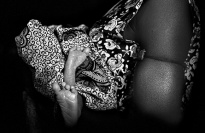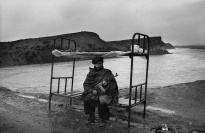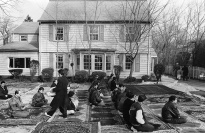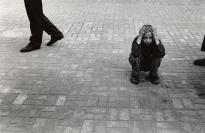About Moving Walls 6
On September 11, with the New York air still thick with dust, there were no answers—only questions. Why did this happen? Who are these people willing to sacrifice themselves to slaughter thousands? Would this become a clash between Islam and the West? If so, what is driving it? And, in a time of crisis, how do we continue to talk about the issues that have long-plagued open societies? Through the uncompromising lenses of six documentary photographers, examining communities from Queens to Guinea Bissau in West Africa, the Open Society Foundations’ Spring 2002 Moving Walls exhibit confronts these questions and many others.
The exhibit is anchored by the work of Iranian-born photographer Abbas. Angered by the fanaticism driving the 1978 Iranian revolution, Abbas resolved to document the internal tensions within Muslim societies that give way to extremism. Islamia, his seven-year photographic exploration of militant Islam, which has taken him through 29 countries, provides a penetrating look at Muslim people within societies veiled by religious and cultural mystery.
Photographer Edward Grazda stays closer to home, focusing his camera on the dozens of communities of New Yorkers who practice Islam. The resulting project, New York Masjid: The Mosques of New York, bears witness to a growing community "engaged in building up the city with a quiet, unassuming energy."
With Guinea Bissau: In the Cool Shade of a Mud Hut, Ami Vitale introduces us to the Fulani, a West African tribe whose unique spiritual universe blends traditional Islamic practices with local beliefs and traditions.
The devastation of war is the subject of Lori Grinker’s project, After War: Veterans from a World in Conflict. Through interviews and photographs, she presents the stories of men, women and children who have survived—barely, in many cases—bloody combat in wars ranging from World War I to Kosovo.
The work of Aleksandr Glyadyelov and Jon Anderson reminds us that even as the world’s eye is turned towards terrorism, the enduring challenges to open society must still be reckoned with. Glyadyelov’s photographs of Ukranian street kids—from his project, Spare—capture the shame and desperation of a country forced, by abject poverty, to abandon its children.
In Caña Brava, Anderson presents Haitian cane cutters living in the Dominican Republic who, while struggling to survive in the declining sugar economy, celebrate a way of life born out of adversity.
Ultimately, the current Moving Walls exhibit asks more questions than it answers. It examines people attempting to reconcile the tension between tradition and modernity. However, by affirming the humanity of their subjects, regardless of creed and nationality, the photographers present the possibility, at least, that there could be an opening for new dialogues on issues affecting open societies around the world.
